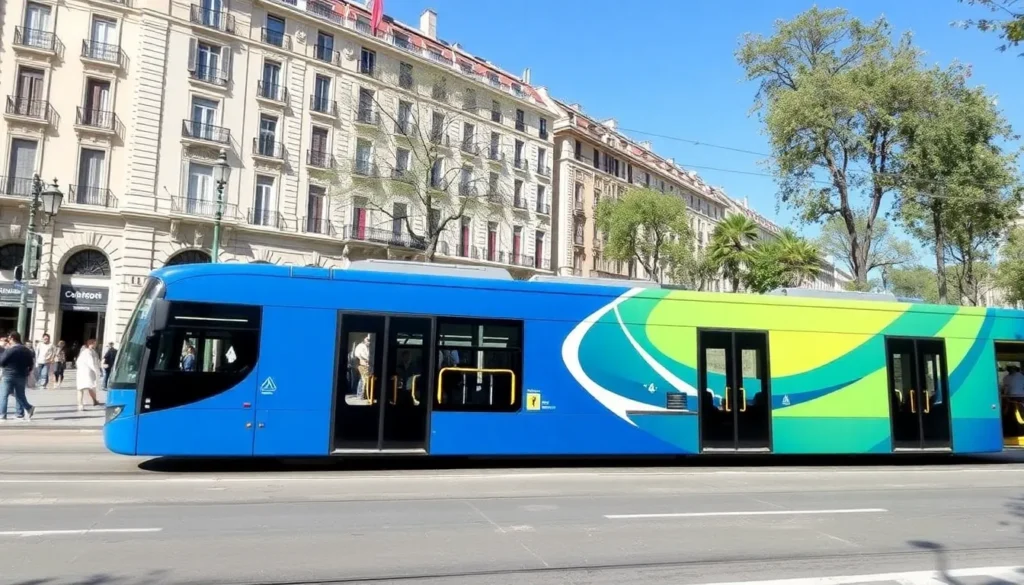Getting Around Barcelona: Public Transport Guide

Barcelona, a city pulsating with energy and culture, offers a unique blend of historic charm and modern conveniences. Navigating this vibrant metropolis can seem daunting at first, but with the right knowledge about its public transportation system, you can easily unlock the secrets of this stunning city. Whether you're a first-time visitor or a seasoned traveler, understanding how to move around efficiently will enhance your experience, allowing you to discover everything from the iconic Sagrada Familia to the hidden gems tucked away in its winding streets.
In this comprehensive guide, you’ll find essential tips on how to get around Barcelona, including an overview of the various public transportation options available to you. Let’s dive in!
Understanding Barcelona's Public Transport System
Barcelona boasts a comprehensive public transport network that includes traditional modes such as metro, buses, trams, and commuter trains, as well as innovative options like electric bike and scooter rentals. This network not only connects the city center with its suburbs but also promotes sustainable mobility in line with current environmental trends. The effectiveness of public transport in Barcelona makes it an excellent choice for both locals and visitors.
The city is divided into different fare zones, which determine ticket prices based on the distance traveled. Familiarizing yourself with these zones is essential to save money while exploring.
Types of transport tickets and cards
Barcelona's public transport system offers a variety of integrated tickets and travel cards, allowing you to use multiple forms of transport under one fare structure. Here’s a breakdown of the options:
- Single Ticket: Ideal for short trips, valid for one journey on any transport.
- T-Casual: A multi-person ticket valid for 10 rides, great for families or groups.
- Barcelona Card: An all-in-one card that provides unlimited travel and discounts on attractions.
- T-Mobilitat: A contactless card for easy travel across various modes of transport.
For more detailed information about ticket types, visit the official TMB website.
Calculating your itinerary
Planning your journey in Barcelona is straightforward, thanks to user-friendly tools. You can use:
- Google Maps: Offers real-time directions and public transport options.
- TMB App: Provides information on schedules, routes, and service updates.
- Moovit: A comprehensive transit app that helps navigate the public transport system.
- Citymapper: An intuitive app that integrates various transport modes for seamless planning.
How to reach Barcelona from the airport
Most travelers arrive in Barcelona via El Prat Airport, which is well-connected to the city center. Here are the main options:
- Aerobus: A direct bus service that runs every 5 to 10 minutes.
- Train: The R2 Nord line connects the airport to various city stations.
- Taxi: Readily available, offering a more comfortable but pricier option.
- Rideshare Services: Services like Uber or Cabify operate in the area.
For a detailed overview of transport options from the airport, check here.
Exploring Barcelona's public transport options
Barcelona’s public transport revolves primarily around the metro, buses, trams, and trains. Here’s an overview of each mode:
The metro: The fastest way to navigate the city
The Barcelona Metro is undoubtedly the quickest method to traverse the city. With 8 lines extending throughout the metropolitan area, you can reach almost any point of interest within minutes. Key stations like Pl. Catalunya, Passeig de Gràcia, and Pl. Espanya provide essential transfer points. This makes the metro an integral part of public transport in Barcelona.
The metro runs on a schedule that varies based on the day and time, with services extending until 2 AM on Fridays and continuous service on Saturdays. Always validate your ticket upon entry to avoid any fare issues.
Urban buses: Enjoy the scenery while you travel
Barcelona’s extensive bus network includes both regular and rapid transit lines, marked by a clear numbering system. The buses, primarily red and white, provide an opportunity to see the city while traveling. Although bus travel might take longer due to traffic, it’s a reliable option with a frequency that generally doesn’t exceed 15-20 minutes, even during peak times. Understanding how to ride a bus in Barcelona is essential for getting around smoothly.
Night buses operate with a separate system, ensuring you can always get home safely after exploring the vibrant nightlife.
Tram lines: A scenic alternative
While the tram system in Barcelona is limited mainly to specific areas like Poblenou, it offers a relaxing way to travel. Lines T4, T5, and T6 connect popular districts while providing a leisurely pace. The Tramvia Blau, a historical tram, also operates in the area, adding a nostalgic touch to your journey.
Rodalies and Ferrocarrils de la Generalitat: Connecting the outskirts
The Rodalies and Ferrocarrils de la Generalitat offer commuter train services connecting Barcelona with nearby towns and suburbs. Although they are more relevant for long-distance travelers, the integration of ticketing with TMB makes them accessible for visitors too. The R2 Nord line even connects to the airport, making it convenient for travel beyond the city.
Funiculars and cable cars: Unique travel experiences
Barcelona offers funiculars and cable cars that not only serve transportation needs but also provide breathtaking views of the city:
- Funicular de Montjuïc: Connects to key attractions on Montjuïc Hill.
- Funicular del Tibidabo: Offers access to the Tibidabo Amusement Park.
- Teleférico de Montjuïc: Provides stunning views while traveling to Montjuïc Castle.
- Teleférico del Puerto: Connects Barceloneta beach with Montjuïc and boasts panoramic views.
Motosharing: A flexible way to explore
For a modern twist on urban mobility, motosharing has gained popularity among both residents and tourists. This service allows you to rent electric scooters through an app, providing a quick and eco-friendly way to navigate the city.
With several providers available, you can easily find a scooter nearby. Prices are competitive, and the convenience of picking up and dropping off scooters at various locations throughout the city makes this an appealing option for those looking to cover more ground.
Bicing: The bike-sharing initiative
For cycling enthusiasts, Bicing is Barcelona's bike-sharing program that promotes eco-friendly transportation. Launched in 2007, it offers various subscription plans, primarily benefiting locals. However, tourists can also find rental options through other providers if they wish to explore the city on two wheels.
Conclusion
Barcelona's public transport system is designed to simplify your travels while allowing you to immerse yourself in the city's vibrant atmosphere. Whether you choose to ride the metro, hop on a bus, or explore by bike or scooter, each option offers a unique perspective of this beautiful city. With this guide, you can navigate Barcelona confidently, making the most of your time in the Catalan capital. The extensive options available in Barcelona public transportation ensure that you can easily reach all the must-visit sites and hidden treasures alike.
 Anaga Rural Park visit planning tips and advice
Anaga Rural Park visit planning tips and advice Travel Guide to Porto Essential Information You Need
Travel Guide to Porto Essential Information You Need Ballestas Islands: Boat Tour of Peru's Galapagos
Ballestas Islands: Boat Tour of Peru's Galapagos Transportation Guide to Galapagos: Getting There and Getting Around
Transportation Guide to Galapagos: Getting There and Getting Around Affordable Accommodation in New York for Budget Travelers
Affordable Accommodation in New York for Budget Travelers Things to see and do in Holbox, the relaxed island in Mexico
Things to see and do in Holbox, the relaxed island in Mexico
Deja una respuesta